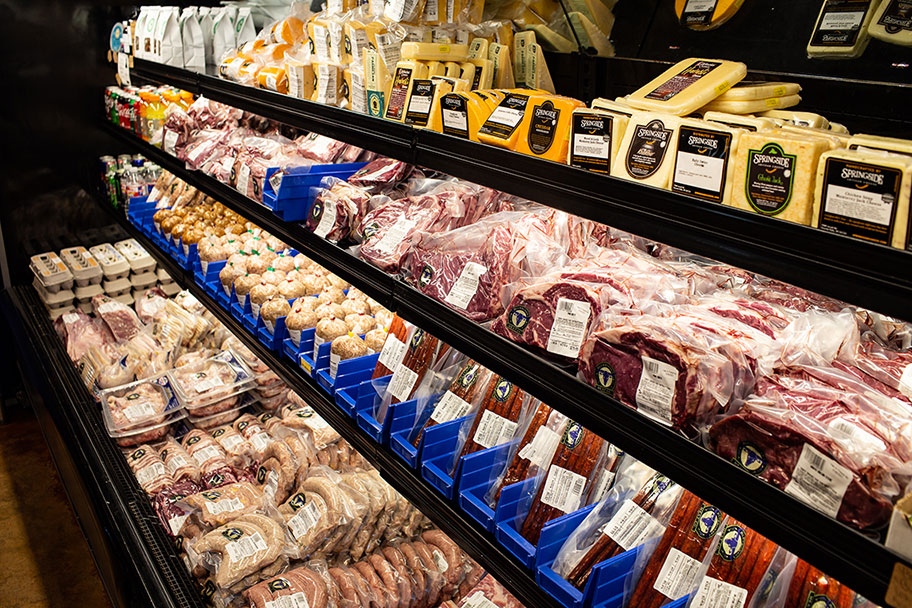Why Bagley Farms Meat Market Edwardsville IL Is the most effective Option for Quality Meats
Why Bagley Farms Meat Market Edwardsville IL Is the most effective Option for Quality Meats
Blog Article
Discover the Art of the Butcher's Cut in a Modern Meat Market
In the ever-evolving landscape of contemporary meat markets, the butcher's cut has actually transcended its conventional origins, combining olden workmanship with modern techniques. Today's butchers are not simply cpus of meat; they are educated artisans who emphasize sustainability and moral sourcing. Their knowledge in selecting and preparing cuts tailored to particular culinary requirements provides an unequaled eating experience. What truly establishes the contemporary butcher apart is their ability to build a deeper connection between customers and the origins of their meat. How do these masters equilibrium custom with development, and what ramifications does this have for the future of meat consumption?
Development of Butchery Methods
The advancement of butchery methods shows an abundant tapestry of advancement and adaptation driven by advancements in innovation, changes in consumer need, and a deeper understanding of meat scientific research. Historically, butchery was a craft passed down via generations, with methods refined over centuries to make best use of return and taste. Nevertheless, the industrial transformation introduced mechanization, changing traditional methods and enabling massive handling.
The mid-20th century saw butchery strategies even more fine-tuned by clinical insights into muscle mass biology and meat aging, boosting both inflammation and taste. Developments like vacuum cleaner product packaging and refrigeration extended product shelf-life, enabling butchers to expand offerings and enhance top quality control. This period also marked the increase of customized tools, such as band saws and meat slicers, which increased precision and effectiveness in meat handling.

The 21st century has actually presented electronic modern technology right into the butchery world. Electronic systems now help in monitoring animal provenance and enhancing cuts to meet particular customer preferences. Additionally, a revival in artisanal butchery has emerged, blending typical abilities with contemporary understanding to cater to consumers looking for moral and sustainable meat alternatives. This evolution highlights a vibrant interaction in between practice and advancement, conference modern needs while preserving the craft's heritage.
Recognizing Meat Cuts
Recognizing the intricacies of meat cuts is important for both butchers and customers seeking quality and worth. For butchers, precise cuts show ability and regard for the craft, making sure marginal waste and optimal yield.

Recognizing muscle mass composition is important; muscle mass used much more often by the pet often tend to be harder and are best matched for slow food preparation approaches, while less-used muscles, like those located in the loin, are extra tender and perfect for barbecuing or roasting. Familiarity with these distinctions equips consumers to make enlightened options, enhancing their cooking endeavors.
Picking High Quality Meat
Choosing the right meat entails greater than just selecting an aesthetically appealing item from the display. bagley farms meat market edwardsville il. The art of choosing top quality meat needs a critical eye and understanding of specific features that represent quality and excellence. Pay attention to the shade; beef should have a brilliant, cherry-red hue, while lamb ought to show a soft pink tone, and pork a pale pink. This suggests the meat is fresh and hasn't been revealed to oxygen for you can look here too lengthy.
Second of all, consider the marbling, which refers to the white streaks of fat within the muscular tissue. Correct marbling is an essential sign of tenderness and taste, as it thaws throughout cooking, enhancing the meat's juiciness. Keep in mind, greater marbling often correlates with premium high quality cuts, such as USDA Prime.
Structure is another important variable; meat should feel firm to the touch, not slimy or overly soft. Additionally, bear in mind the aroma. Fresh meat must have a tidy, neutral odor, cost-free from any kind of sour or repulsive smells.
Coupling Cuts With Food Preparation Approaches

Conversely, tougher cuts like brisket and chuck roast are abundant in collagen, which damages down into gelatin when cooked slowly. These cuts are ideal for braising or sluggish roasting, permitting the meat to soften in time and establish deep, intricate tastes. Similarly, cuts such as short ribs and pork shoulder prosper with slow-cooking approaches, where expanded cooking times transform their robust structures right into delicious recipes.
Lamb shanks and oxtail, which call for prolonged cooking to tenderize, are perfect candidates for stewing or sluggish simmering. These techniques coax out rich, hearty flavors while preserving dampness. By recognizing the distinct characteristics of each cut, chefs and home cooks alike can elevate their cooking creations, guaranteeing each meal is both satisfying and memorable.
The Butcher's Role Today
Browsing the progressing landscape of the modern meat market, the butcher's function today extends beyond plain preparation of cuts. Contemporary butchers are cooking artisans, instructors, and advocates for lasting practices.
Along with crafting accurate cuts, butchers currently engage straight check my site with consumers, using cooking advice and customizing selections to fit specific requirements and choices. Their experience in meat aging, marbling, and flavor accounts encourages consumers to make enlightened decisions, boosting their culinary experiences. This individualized service exemplifies the butcher's advancing role as a trusted expert in the kitchen area.
In addition, butchers are critical in decreasing waste, utilizing whole click for more animals to develop diverse products such as sausages and supplies. This comprehensive method not just respects the animal yet additionally aligns with contemporary sustainability goals. By doing this, the modern-day butcher personifies both tradition and development, adjusting to an ever-changing market while maintaining the virtuosity and integrity of their craft.
Conclusion
Mastery in recognizing diverse meat cuts and quality indications encourages butchers to supply informed recommendations, aligning details cuts with optimum cooking methods. By recognizing historic methods while embracing modern demands, the butcher's duty continues to be important in today's sophisticated meat market.
Report this page